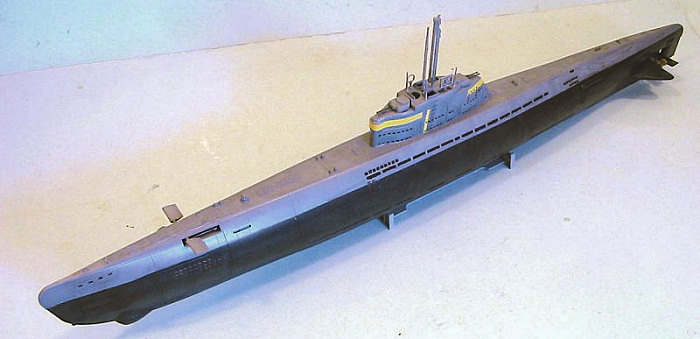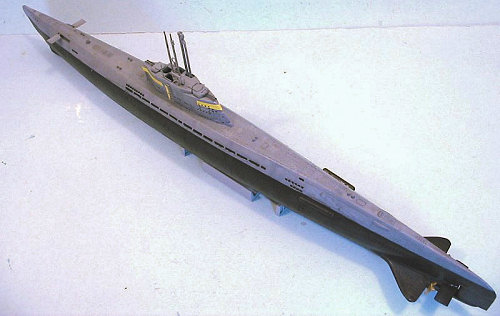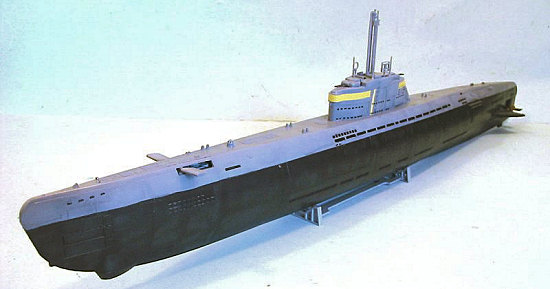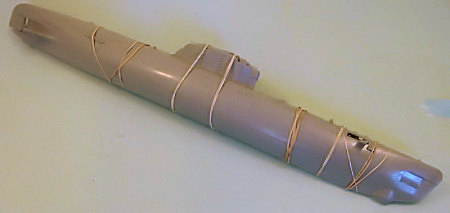
| KIT: | Revell 1/144 Type XXI U-boat |
| KIT #: | 05004 |
| PRICE: | £13.99 |
| DECALS: | Five options |
| REVIEWER: | Tom Cleaver |
| NOTES: |

| HISTORY |
The Type XXI U-boat was the most significant submarine since the original Holland H-1, which proved that the concept of a submarine could work reliably. While everything after the original Holland boat to the Type XXI was a “submersible,” i.e., a surface ship that could submerge for limited periods of time, with much lower performance than was possible on the surface. The Type XXI was the first true submarine, a ship designed to operate with higher performance underwater than on the surface. While the Type XXI arrived too late to participate in the Second World War, it revolutionized all subsequent submarine designs. As the U.S. Navy discovered with the two Type XXIs it operated for test purposes between 1946-49, the Type XXI would have been nearly unstoppable with Second World War antisubmarine technology and tactics. One can see the influence of the Type XXI in the U.S.S. Nautilus, the first nuclear-powered submarine.
The “happy time” for the German U-boats was coming to an end in 1942. The
British were reading the U-boat codes through the Ultra Program, and Grand
Admiral Donitz’s requirement that the boats remain in contact with headquarters
meant that convoys could be routed around gathering wolfpacks. Additionally,
the “Atlantic Gap” was covered as more long range patrol
 aircraft were employed,
their presence forcing the U-boats to submerge, where their low underwater speed
and short endurance meant that convoys could more easily escape them. In the
Spring of 1943, the Allies introduced centimetric radar, which considerably
eased the search for surfaced U-boats, with the result that in May 1943 U-boat
losses began to skyrocket, and the loss curves never went back down as escort
carriers and hunter-killer teams arrived on the scene.
aircraft were employed,
their presence forcing the U-boats to submerge, where their low underwater speed
and short endurance meant that convoys could more easily escape them. In the
Spring of 1943, the Allies introduced centimetric radar, which considerably
eased the search for surfaced U-boats, with the result that in May 1943 U-boat
losses began to skyrocket, and the loss curves never went back down as escort
carriers and hunter-killer teams arrived on the scene.
One answer was the use of the “snorkel,” a Dutch invention that allowed a submerged submarine cruising at periscope depth to get sufficient air to run the diesel engines. Unfortunately, all this did was allow U-boats to cruise for an extended period at 3-4 knots, which was far to slow as compared with their speed on the surface of 17-18 knots. Additionally, the noise of the diesels made a snorkeling U-boat an easily-discovered target for a sonar-equipped hunter.
As early as 1933, Hellmuth Walther company had presented a proposal for a U-boat that would be powered by a hydrogen-peroxide engine while submerged, which would provide far better performance and submerged endurance. No action was taken on the proposal until 1941, but by 1943 development was moving too slowly on this idea. In the face of the losses in the Spring of 1943, something drastic had to be done if the German Navy was to continue fighting the Battle of the Atlantic with any hope of victory.
Two engineers, Schuerer and Broecking, proposed using the huge fuel tanks in the lower pressure hull of the Walther U-boat to store batteries, thus tripling the boat's battery capacity. Their calculations showed the performance of the new submarine would be better than the conventional U-boat Type VII and IX, though not as good as of the Walther. Given the delays with the Walther proposal, that was good enough for Donitz, and development went ahead. In June, 1943, preliminary design was completed. The new U-boat, designated Type XXI, would have a displacement of 1620 tons, a top submerged speed of 18 knots, advanced sonar, radar, and a snorkel. Approval for construction of Type XXI prototypes was given by Hitler in August.
 Conventional construction, with boats built from start to finish on a single
slip, would take 18 months to build a Type XXI, which meant the prototypes would
be completed in November 1944,with production boats ready for operations use in
1946, which was unacceptable. Albert Speer, Minister for Armaments, consulted
mass production experts in the auto industry and a plan was developed in which
there would be no prototypes, with the boats built in 8 construction groups
prefabricated in other factories and welded together at the shipyard. Using this
method, total construction time for a Type XXI would be 6 months. Orders for
construction were given to various shipyards in November of 1943, while the
production of conventional U-boats was halted. Initial production was set at 300
boats, leading to an eventual 1,500, which would mean finishing three a week by
the middle of 1944.
Conventional construction, with boats built from start to finish on a single
slip, would take 18 months to build a Type XXI, which meant the prototypes would
be completed in November 1944,with production boats ready for operations use in
1946, which was unacceptable. Albert Speer, Minister for Armaments, consulted
mass production experts in the auto industry and a plan was developed in which
there would be no prototypes, with the boats built in 8 construction groups
prefabricated in other factories and welded together at the shipyard. Using this
method, total construction time for a Type XXI would be 6 months. Orders for
construction were given to various shipyards in November of 1943, while the
production of conventional U-boats was halted. Initial production was set at 300
boats, leading to an eventual 1,500, which would mean finishing three a week by
the middle of 1944.
The first Type XXI laid down was U-2501, on April 3, 1944. She was launched May 12, 1944, and commissioned on June 27th. Trials demonstrated that the proposed performance was almost met. While U-2501 had a slightly slower submerged speed than was expected, the boat performed admirably. Tests demonstrated that the XXI would only have to snorkel for 3 hours a day, running at a silent submerged cruising speed of 5 knots. The Type XXI had much better crew facilities, such as a freezer for food, three heads, a shower, air conditioning, and ultraviolet lighting for prolonged submergence. Equipped with a hydraulic torpedo reload system, all 6 tubes could be reloaded in 10 minutes, which was less time than it took to reload one tube on the Type VIIC. The Type XXI could fire 18 torpedoes in less than 20 minutes, and the total war load was 23 torpedoes, or 17 torpedoes and 12 sea mines. With three times the battery capacity of a Type VIIC, the Type XXI could travel submerged at 5 knots for two or three days before having to recharge the batteries. The submarine was designed to submerge once it reached deep water after leaving port, and to remain submerged for the entire war patrol.
New combat tactics were developed for the Type XXI for submerged combat. The U-boat would locate a convoy with its advanced sonar, make a high-speed submerged approach to get past the escorts and under the convoy at the maximum operating depth of 440 feet and then fire spreads of pattern-running torpedoes.
Despite being given top priority, the Electro-boat program slowed down, and planned construction figures were unmet. Between 1943 and 1945, 118 Type XXI U-boats were built by Blohm & Voss in Hamburg, AG Weser in Bremen, and F. Schichau in Danzig.. By the time of the German surrender, only one Type XXI and six smaller Type XXIII's were fully operational. Through Ultra, the Allies had learned about the program and increased bombing of shipyards. Additionally, the new U-boats were significantly different from the earlier boats, requiring a lengthy training program for the crews to be familiar with the boat and the new tactics. Intense Allied mining in the Baltic Sea training areas resulted in several boats being lost on training missions.
 Only one Type XXI made it to sea on a war patrol, U-2511, under the command of
Korvettenkapitän Adalbert Schnee. The boat left Kiel on March 16, 1945
for the Norwegian base at Horten. She was supposed to depart on patrol on March
26, but she sustained periscope damage and was delayed, finally departing on
April 18, but was forced to return to Bergen the next day due to diesel
problems. She finally departed Bergen on April 30, with orders to patrol the
Caribbean. On May 4, 1945, the U-boat had a golden opportunity to sink HMS
Norfolk, as U-2511 penetrated the escort screen and got within 500 yards of the
heavy cruiser. Having received a cease-fire order hours earlier, Schnee did not
attack and instead slipped away from the cruiser and its escorts, completely
undetected. Schnee returned to Bergen on May 5 and surrendered. He spoke with
officers of HMS Norfolk a few days later, who found it unbelievable that
Schnee was able to get so close without any sonar contact. Too little, too late!
Only one Type XXI made it to sea on a war patrol, U-2511, under the command of
Korvettenkapitän Adalbert Schnee. The boat left Kiel on March 16, 1945
for the Norwegian base at Horten. She was supposed to depart on patrol on March
26, but she sustained periscope damage and was delayed, finally departing on
April 18, but was forced to return to Bergen the next day due to diesel
problems. She finally departed Bergen on April 30, with orders to patrol the
Caribbean. On May 4, 1945, the U-boat had a golden opportunity to sink HMS
Norfolk, as U-2511 penetrated the escort screen and got within 500 yards of the
heavy cruiser. Having received a cease-fire order hours earlier, Schnee did not
attack and instead slipped away from the cruiser and its escorts, completely
undetected. Schnee returned to Bergen on May 5 and surrendered. He spoke with
officers of HMS Norfolk a few days later, who found it unbelievable that
Schnee was able to get so close without any sonar contact. Too little, too late!
After the war, the U.S. Navy took over two Type XXI U-boats: U-2513 - which had been commanded by U-boat ace Erich Topp - and U-3008. In August 1946 U-2513 began a complete overhaul in Charleston, South Carolina, At the end of September she traveled to Key West, Florida where she underwent six months of evaluation tests in conjunction with the development of submarine and antisubmarine tactics. The results proved the new U-boat would have revolutionized undersea warfare, and led to the development of the Greater Underwater Propulsion Power Program (GUPPY) to modernize U.S. Fleet boars because of the test results. Sent to Portsmouth, New Hampshire, U-2513 was eventually taken out of service in 1949 and sunk off Key West during anti-submarine rocket tests by the destroyer U.S.S. Robert A. Owens on October 7, 1951. U-3008 was overhauled at Portsmouth at the same time U-2513 was overhauled at Charleston, and she operated out of New London in 1946-47 until she was sent to Key West for operation by the Operational Development Force, which used the submarine until February 1948. She returned to Portsmouth where she was placed out of service until she was sunk in a series of anti-submarine weapons tests in 1954. The wreck was raised in 1955 and sold at Roosevelt Roads for scrap in 1956, being disassembled for scrap in 1957.
The Soviet Navy is known to have operated at least four Type XXIs after the war,
U-3515, U-2529, U-3035, and U-3041 which were commissioned B-27, B-28, B-29, and
B-30 respectively. Experience with these boats led to the development of the
Zulu and Whiskey class submarines which were operational from the
early 1950s through the mid-1960s. The Royal Navy operated U-3017 as HMS
N41, while the French Navy operated U-2518 as Roland Morillot.

U-2540, which was commissioned on October 19,1944, was scuttled near the Flensburg lightship outside Hamburg harbor on May 4, 1945, after suffering damage in an Allied bombing raid. The U-boat was raised and salvaged in the mid-1950s, and was taken into the West German Bundesmarine in 1960 as Wilhelm Bauer, becoming the only operational Type XXI in the world through the 1960s and early 1970s. In 1984, it was put on display in the Technical Museum in Bremerhaven, where it is the only complete Type XXI in existence (three Type XXIs have been discovered the past ten years inside the ruins of the Hamburg U-boat construction dock, though they can never be salvaged).
While the Type XXI was too late for combat in World War II, its revolutionary design changed submarines forever from that day forward.
| THE KIT |
Revell first brought out this kit of the Type XXI U-boat in the early 1990s, and if I remember correctly it was the first submarine model in 1/144 scale. Developed and produced “to a price,” it is a simple model with 41 parts, molded in medium grey plastic with decals provided for five boats. While simple in kit design, the result is a nicely-detailed model that can be the subject of super-detailing to create an excellent model. I remember seeing one of these done as a waterline model in an underway diorama, with the drain holes all drilled out and water cascading from them, which I thought was one of the most effective submarine models I had ever seen.
| CONSTRUCTION |
 Submarine models are easy. Due to their basic design, there just isn’t a lot
there. I find that both airplane modelers and science fiction modelers like
submarine models; I think this could be due to the fact that submarines are the
first “space ships” - vehicles designed to take humans into an environment they
could not survive in otherwise, for travel in worlds previously unknown.
Submarine models are easy. Due to their basic design, there just isn’t a lot
there. I find that both airplane modelers and science fiction modelers like
submarine models; I think this could be due to the fact that submarines are the
first “space ships” - vehicles designed to take humans into an environment they
could not survive in otherwise, for travel in worlds previously unknown.
Construction of this kit is particularly easy, if one does it out of the box. Fit is good overall, and I only had to use any filler to take care of some sinkholes on the fin tips of the rear horizontal stabilizing fins. The rest was assembled without putty or Mr. Surfacer, and the centerline seam on the hull was easily sanded away.
Super-detailing could include opening the drain holes in the hull and conning tower, and scratchbuilding areas of the inner pressure hull. As I said, I once saw a model done from this kit in which that had been done, and it looked very realistic and effective.
| COLORS & MARKINGS |
 Painting:
Painting:
I painted the lower hull with Tamiya “NATO Black,” lightening it with “Sky Grey” and going back over it to give a multi-hue finish. I then masked this off and painted the upper area with Xtracrylix “Ocean Grey” which I lightened with “Sea Grey” and faded. When this was dry, I hand-painted the drain holes black. From a distance, sitting on a shelf, this looks effective. The screws were painted brass.
Decals:
I used the kit decals to do U-3504. They went on without problems.
| CONCLUSIONS |
As I said above, the Type XXI is one of the most important submarines ever built in terms of its influence on submarine design and operations, and as such it is certainly worthy of inclusion in any collection of submarine models. 1/144 is a perfect scale for submarines -big enough to allow good detail, and not so big one has to put an addition on to the house to display it. The Revell kit is inexpensive and easy to construct. If you’re an airplane modeler who has temporarily “hit the wall” with airplane models, this could be a welcome side trip to reacquaint you with the joy of model building for its own sake.
Thanks to Hannant’s for the review copy. Get yours at: www.hannants.co.uk
November 2006
If you would like your product reviewed fairly and quickly by a site that has over 325,000 visitors a month, please contact me or see other details in the Note to Contributors.